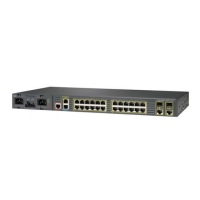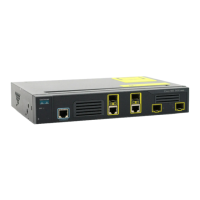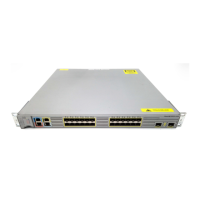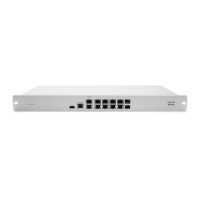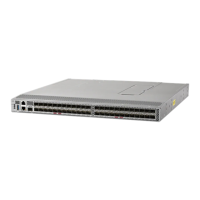33-20
Cisco ME 3400 Ethernet Access Switch Software Configuration Guide
OL-9639-07
Chapter 33 Configuring QoS
Understanding QoS
This example uses a policy map to remark a packet. The first marking (the set command) applies to the
QoS default class map that matches all traffic not matched by class AF31-AF33 and sets all traffic to an
IP DSCP value of 1. The second marking sets the traffic in classes AF31 to AF33 to an IP DSCP of 3.
Switch(config)# policy-map Example
Switch(config-pmap)# class class-default
Switch(config-pmap-c)# set ip dscp 1
Switch(config-pmap-c)# exit
Switch(config-pmap)# class AF31-AF33
Switch(config-pmap-c)# set ip dscp 3
Switch(config-pmap-c)# exit
Switch(config-pmap)# exit
Switch(config)# interface fastethernet0/1
Switch(config-if)# service-policy input Example
Switch(config-if)# exit
Marking and Queuing CPU-Generated Traffic
You can mark the CPU-generated traffic by entering the cpu traffic qos global configuration command.
You can use this command to mark the CPU-generated control plane packets with CoS, DSCP and IP
precedence values. You can also use QoS groups to mark the CPU-generated traffic with a qos-group
number. See
“Classification Based on QoS Groups” on page -10.
The output policy map that is attached to each port determines the output queue for CPU-generated
traffic when traffic is sent though that port. Using the cpu traffic qos global configuration command,
you can match the QoS parameter values to an output policy-map and assign them to a specific queue,
or perform other actions on the CPU-generated traffic. The default egress queue value is 2. However, if
there is no output policy attached to the port, the CPU-generated traffic is sent through the first
non-priority queue defined in the output policy map. You can also mark native VLAN traffic and tag it
by entering the vlan dot1q tag native global configuration command.
When you configure the cpu traffic qos marking for Ethernet or IP traffic, the control plane traffic that
the CPU generates is marked with the values that you specify. All control plane traffic is marked with
these values, except for Connectivity Fault Management (CFM) traffic. Cisco IOS IP Service Level
Agreements (SLAs) traffic that uses the CFM layer for transacting the messages is not affected, but IP SLAs
traffic that uses UDP or other networking protocols is affected by this feature.
Congestion Management and Scheduling
MQC provides several related mechanisms to control outgoing traffic flow. These mechanisms are
implemented in output policy maps to control output traffic queues. The scheduling stage holds packets
until the appropriate time to send them to one of the four traffic queues. Queuing assigns a packet to a
particular queue based on the packet class, and is enhanced by the WTD algorithm for congestion
avoidance. You can use different scheduling mechanisms to provide a guaranteed bandwidth to a
particular class of traffic while also serving other traffic in a fair way. You can limit the maximum
bandwidth that can be consumed by a particular class of traffic and ensure that delay-sensitive traffic in
a low-latency queue is sent before traffic in other queues.
The switch supports these scheduling mechanisms:
• Traffic shaping
You use the shape average policy map class configuration command to specify that a class of traffic
should have a maximum permitted average rate. You specify the maximum rate in bits per second.
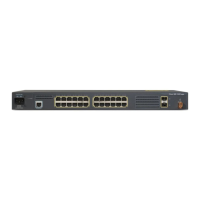
